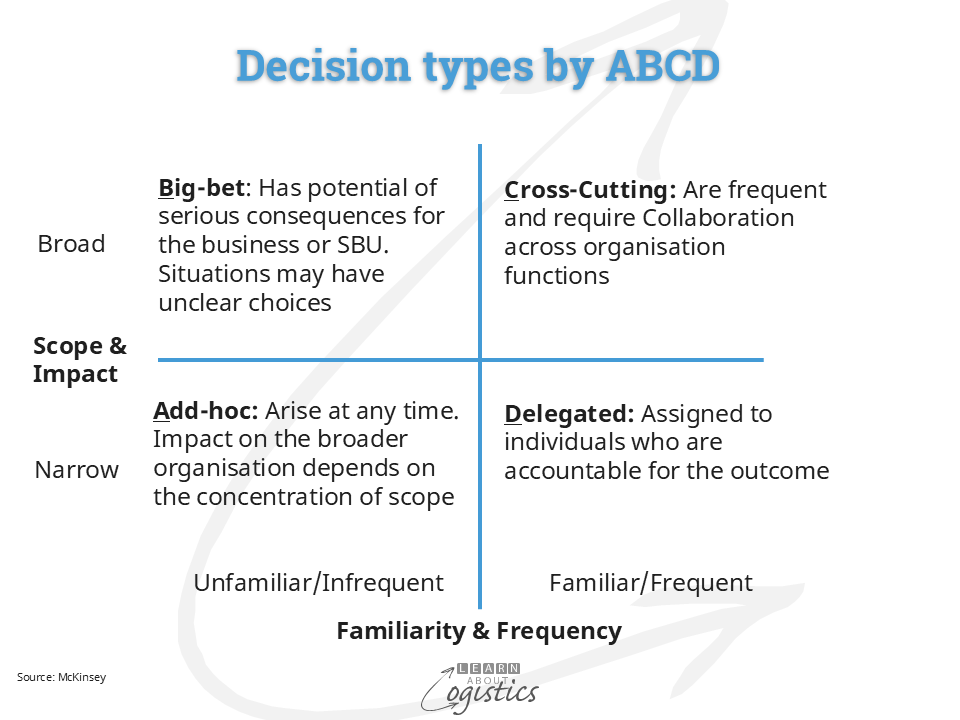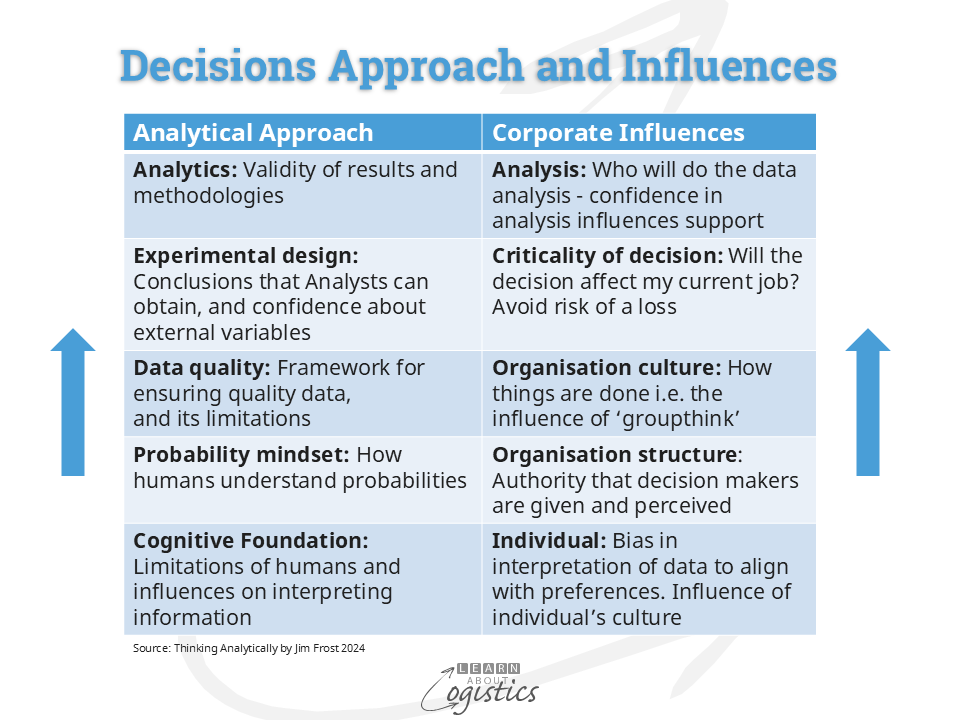Are decisions better?
Has decision making become more complex? Although the impact of decisions about supply chains can extend across enterprises, are suppliers and customers involved? And is there clarity about which are strategic, tactical and operational decisions for supply chains and who is responsible? Most important, are decisions considered to be ‘better’ than those made in previous times?
Survey since 2019 indicate there has been a substantial increase in the number of decisions made in businesses and supply chains; that managers are spending more time making decisions; that more people are involved in making a decision. Yet satisfaction with the quality of the decisions made remains low. But why this situation? Responses to the surveys identified the following reasons:
- Data overload: Overwhelmed by the volume, complexity and ambiguity of data and information received.
- Technology: A challenge, due to insufficient training and use, to extract and identify insights of value to the business from the dashboards and data analytics tools available.
- Improvements in decision making are unlikely from installing the latest analytics software
- Few people in Supply Chains disciplines (Procurement, Operations Planning and Logistics) have skills and experience in quantitative analysis
- Low cost of communications has enabled more people from different functions and geographies to be involved in decisions; but without clarity in the organisation concerning involvement in and authority for making decisions
- Organisation complexity: Accountability is clouded by the mix of different objectives across products, functions and regions. This has enabled the number of people involved in decisions to increase, which also makes it difficult for senior management to clearly delegate decisions.
The outcome is too many meetings (especially electronic) led by people who are not trained in the skills required, and involving too many people with a varying interest in outcomes from the decision. Also, they may influence the decision based on their own (or their group’s) motives.
Types of decisions
It is preferable to think of decisions within categories, as that helps to structure the decision process, and define accountabilities. The consulting firm McKinsey has placed decision types into the familiar four box structure, with measurement of Familiarity and Frequency on the x axis and Scope & Impact on the y axis:

- Ad-hoc: Can occur at any time. As it is unplanned, there is likely to be a requirement for an urgent decision, so clarity of need is required.
- Big-bet: The decision can have serious consequences for the business or strategic business unit (SBU), including their supply chains. Note that a decision for an enterprise which is in the Delegated category could be a Big-bet decision for an individual business unit.
- Cross-cutting: Requires Collaboration across organisation functions, which is a need through the Sales & Operations Planning process. These decisions involve people from different parts of the organisation who may have made prior decisions. Therefore, the process of how the discussions occur and decision made, including the people involved and timing, is a key factor in success of the final decision.
- Delegated: Frequent decisions that are narrow in scope and handled by an individual or small team, which are accountable for the decisions and are empowered to respond with revised decisions as situations change. Delegation provides ownership and accountability for decisions with a delivery date.
Decisions are a process
Except for Ad-hoc decisions, making a business decision is typically not an event, but a process. The Cross-cut decision process should be designed to include the meeting structure which is so important for effective decisions – for example the structure of S&OP meetings to keep them short and focussed. However, for Delegated decisions, a carefully defined process (that could be a tick the box exercise) is not required, as it can slow the speed (and enthusiasm) for making decisions.
Managing the meeting process, such as for S&OP, requires its own skill set, especially framing the questions to be asked of individuals in the group. The first step is for the group to agree on what must be decided. The ensuing discussion requires the management of group dynamics, when identifying and analysing the available critical data, to arrive at an agreed decision.
Most business decisions are collaborative, which can be good, but the challenges to be managed include biases of individuals that are not known, ‘groupthink’ and forceful voices driving their view for consensus. Another consideration is that decisions about the future (such as in S&OP) are made under conditions of uncertainty, so ‘gut feelings’, and biases (which may be called intuition) are too often relied on by participants, rather than analysis.
An analytical approach
This refers to working through a problem using available facts, reasoning and a logical approach, which enables new insights about a problem. Divide the problem into segments that are understandable and manageable using both qualitative and quantitative data, but which can be substantiated. Analyse the segments’ data for patterns; then provide conclusions from the analysis and integrate the individual results into the consolidated decision.
A book that provides a guide for making data-driven decisions is Thinking Analytically by Jim Frost. Published by Statistics by Jim Publishing, State College, Pennsylvania, USA, 2024. The book is available through Amazon international region locations.
The book is readable and recommended, as Jim Frost is a practitioner who ‘walks the talk’. He states that “Analytical Thinking is both art and science, which requires a mindset and tools for thinking analytically about problems, use data and information and come to unbiased conclusions, while avoiding common errors”. The book provides a basis for thinking about supply chain problems that involve ‘weighing’ the value of data and information.
The steps through Jim Frost’s analytical approach are shown on the left side of the table below. On the right side is the equally important list of corporate influences that can (and do) affect the value of decisions.

The corporate influences on decisions illustrate that more and ‘better’ data, which is analysed using the latest technology tools will not automatically lead to better decisions. When making decisions, consider that human behaviour has people with biases and uncritical opinions. Therefore, be aware of the potential corporate influences and use an analytical approach to improve your decision-making capabilities.

